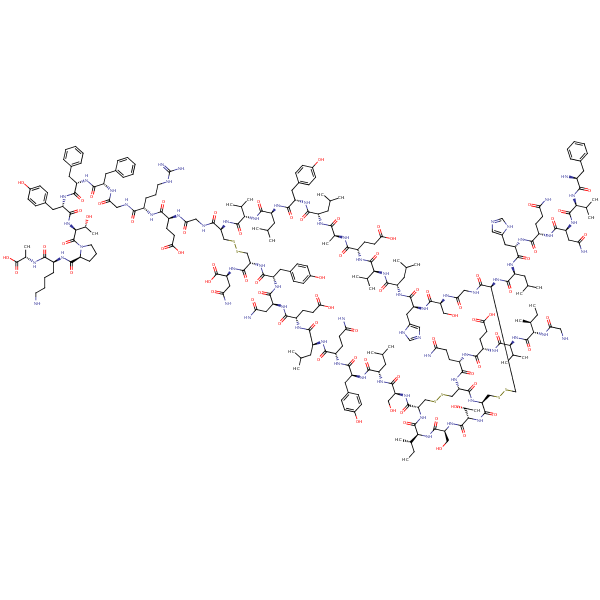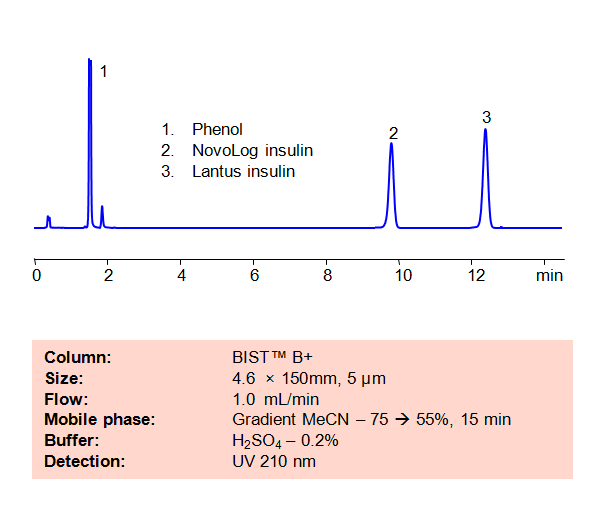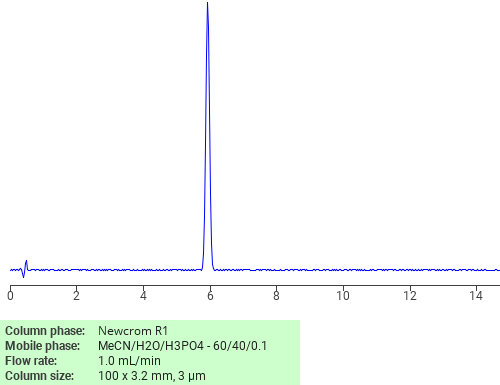| CAS Number | 12584-58-6 |
|---|---|
| Molecular Formula | C256H381N65O76S6 |
| Molecular Weight | 5777.601 |
| InChI Key | NOESYZHRGYRDHS-ZYCCASTOSA-N |
| LogP | 4.35 |
| Synonyms |
|
Applications:
HPLC Method for Analysis of Insulin on BIST™B+ Column
July 8, 2022
| Separation type: Bridge Ion Separation Technology, or BIST™ | ||||||||||||||
| High Performance Liquid Chromatography (HPLC) Method for Analysis of Insulin.
Insulin is an anabolic peptide hormone naturally produced in the pancreas that regulates the body’s glucose levels. It is also synthesized as a treatment drug for those with Diabetes who can’t regulate their own blood sugar levels naturally. Two well-known forms of synthetic insulin are NovoLog and Lantus. NovoLog is a fast-acting version of insulin and can be used by both Type-1 and Type-2 Diabetes patients, whereas Lantus is a long-acting version of insulin that is primarily used by Type-2 Diabetes patients (and by Type-1 patients under the age of 6). Using SIELC’s newly introduced BIST™method, these two forms of insulin can be separated and retained on a positively-charged anion-exchange BIST™B column. There are two keys to this retention method: 1) a multi-charged, negative buffer, such as Sulfuric acid (H2SO4), which acts as a bridge, linking the positively-charged amine analytes to the positively-charged column surface and 2) a mobile phase consisting mostly of organic solvent to minimize the formation of a solvation layer around the charged analytes. This method actually utilizes a gradient that lowers the MeCN concentration over time; this reduces the retention effects on the insulin analytes, allowing for quicker elution times while still maintaining clear selectivity and separation. Using this new and unique analysis method, two different manu can be retained and UV detected at 210 nm. |
||||||||||||||
|
Application Column
BIST B+
BIST™ columns offer a unique and effective way to achieve separations that were traditionally challenging or even impossible with other HPLC columns. With the use of a special mobile phase, these ion exchange columns provide very strong retention for analytes with the same charge polarity as the stationary phase, unlocking new chromatography applications. What makes BIST™ columns stand out is their proprietary surface chemistry, which results in superior selectivity, resolution, and sensitivity. These columns offer a simple, efficient solution for a variety of analytical challenges, making them an excellent choice for researchers and analysts across many different fields. To learn more about the technology that powers BIST™ columns and to explore related applications, check out https://BIST.LC.
Select optionsInsulin, neutral

Separation of Insulin, neutral on Newcrom R1 HPLC column
May 16, 2018
Insulin, neutral can be analyzed by this reverse phase (RP) HPLC method with simple conditions. The mobile phase contains an acetonitrile (MeCN), water, and phosphoric acid. For Mass-Spec (MS) compatible applications the phosphoric acid needs to be replaced with formic acid. Smaller 3 µm particles columns available for fast UPLC applications. This liquid chromatography method is scalable and can be used for isolation impurities in preparative separation. It also suitable for pharmacokinetics.
Application Column
Newcrom R1
The Newcrom columns are a family of reverse-phase-based columns. Newcrom A, AH, B, and BH are all mixed-mode columns with either positive or negative ion-pairing groups attached to either short (25 Å) or long (100 Å) ligand chains. Newcrom R1 is a special reverse-phase column with low silanol activity.
Select options




